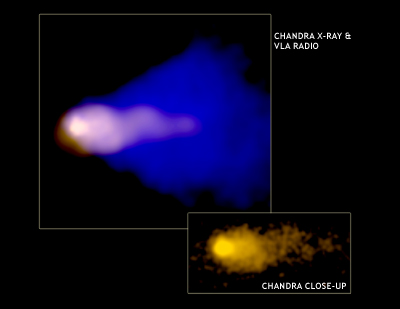
The Mouse, a.k.a. G359.23-0.82, gets its name from its appearance in radio images that show a compact snout, a bulbous body, and a remarkable long, narrow, tail that extends for about 55 light years (see radio image below). The image above, a composite X-ray (gold) and radio (blue), shows a close-up of the head of the Mouse where a shock wave has formed as the young pulsar plows supersonically through interstellar space.
The X-ray cloud consists of high-energy particles swept back by the pulsar’s interaction with the interstellar gas. Near the front of the cloud an intense X-ray source marks the location of the pulsar, estimated to be moving through space at about 1.3 million miles per hour. A cone-shaped cloud of less energetic, radio-wave-emitting particles envelopes the X-ray cloud.
Astronomers are as freewheeling as rock-climbers when it comes to naming anything. Still, this is one of the most interesting recent images from Chandra.















Yeah, thats cool, but you can’t do supersonic in interstellar space. Ya’ see, they ain’t no damn air out there, means they ain’t no molecules to wiggle around to make sound, and wit’out no damn sound ya can’t have supersonic. I know they movin’ fast, but they ain’t movin’ supersonic.
Super Light? Nah, that wouldn’t work, either.
Well it would really make your morning to have that slam into the planet whilst drinking your coffee. The Universe is too violent for Biologicals, I think I’ll go back to bed.
RT, just hang on, the whole biological deal is just the first stage, we do that thing like the frogs, what the hell is it?..Guppies to frog legs, something like that, hell it’s too hard to fit in me brain right now but the next deal is is a whole lot better deal, where ya reproduce by getting it on with a star…that’s just too hot to think about but the kids’re cute.